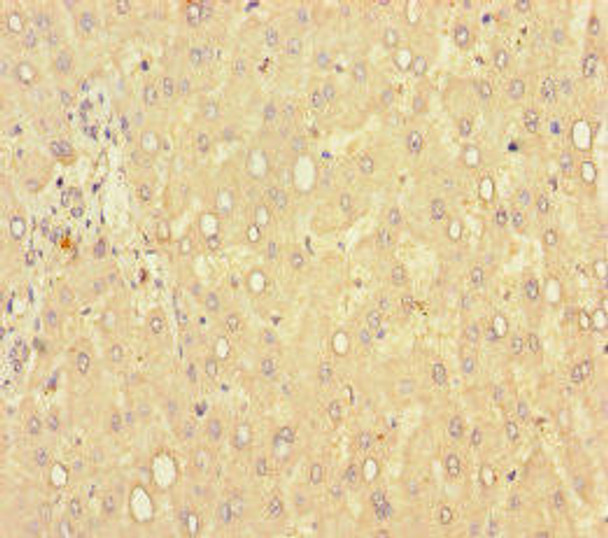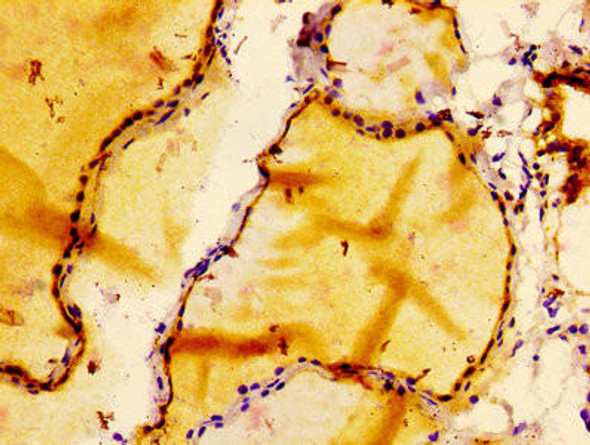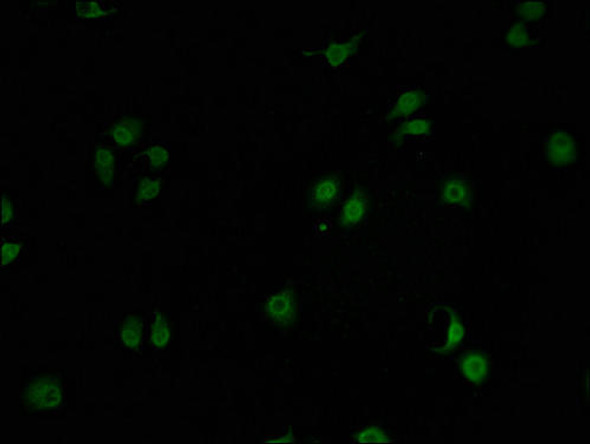GLCE Antibody (PACO27013)
- SKU:
- PACO27013
- Product Type:
- Antibody
- Reactivity:
- Human
- Mouse
- Rat
- Host Species:
- Rabbit
- Isotype:
- IgG
- Applications:
- ELISA
- WB
- IHC
- Antibody Type:
- Polyclonal Antibody
- Conjugation:
- Unconjugated
Description
GLCE Antibody (PACO27013)
The GLCE Polyclonal Antibody (PAC027013) is a valuable tool for research involving GLCE, a key enzyme involved in the regulation of heparan sulfate proteoglycan biosynthesis. This antibody, produced in rabbits, exhibits high reactivity with human samples and has been validated for use in Western blot applications. By specifically binding to the GLCE protein, researchers can accurately detect and analyze its expression in various cell types, making it an excellent choice for studies in glycobiology and cancer research.GLCE, also known as glucuronic acid epimerase, plays a crucial role in modulating the structure and function of heparan sulfate proteoglycans, which are essential for cell signaling, adhesion, and growth regulation.
Dysregulation of GLCE has been implicated in various diseases, including cancer and developmental disorders, making it a potential target for therapeutic intervention. By studying the activity of GLCE, researchers can gain insights into its role in disease pathology and develop novel treatments targeting this enzyme.
| Antibody Name: | GLCE Antibody (PACO27013) |
| Antibody SKU: | PACO27013 |
| Size: | 50ug |
| Host Species: | Rabbit |
| Tested Applications: | ELISA, WB, IHC |
| Recommended Dilutions: | ELISA:1:2000-1:10000, WB:1:1000-1:5000, IHC:1:20-1:200 |
| Species Reactivity: | Human, Mouse, Rat |
| Immunogen: | Recombinant Human D-glucuronyl C5-epimerase protein (29-617AA) |
| Form: | Liquid |
| Storage Buffer: | Preservative: 0.03% Proclin 300 Constituents: 50% Glycerol, 0.01M PBS, PH 7.4 |
| Purification Method: | >95%, Protein G purified |
| Clonality: | Polyclonal |
| Isotype: | IgG |
| Conjugate: | Non-conjugated |
 | Western blot All lanes: GLCE antibody at 12µg/ml Lane 1: Rat liver tissue Lane 2: Mouse kidney tissue Secondary Goat polyclonal to rabbit IgG at 1/10000 dilution Predicted band size: 71 kDa Observed band size: 71 kDa . |
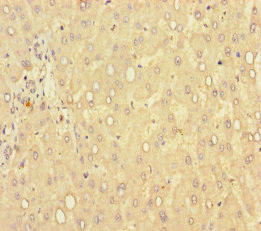 | Immunohistochemistry of paraffin-embedded human liver tissue using PACO27013 at dilution of 1:100. |
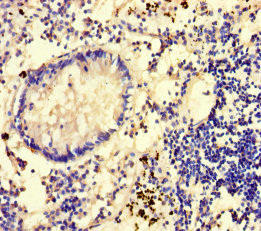 | Immunohistochemistry of paraffin-embedded human appendix tissue using PACO27013 at dilution of 1:100. |
| Background: | Converts D-glucuronic acid, residues adjacent to N-sulfate sugar residues to L-iduronic acid, residues, both in maturing heparan sulfate (HS) and heparin chains. This is important for further modifications that determine the specificity of interactions between these glycosaminoglycans and proteins. |
| Synonyms: | D-glucuronyl C5-epimerase (EC 5.1.3.17) (Heparan sulfate C5-epimerase) (Hsepi) (Heparin/heparan sulfate:glucuronic acid, C5-epimerase) (Heparosan-N-sulfate-glucuronate 5-epimerase), GLCE, KIAA0836 |
| UniProt Protein Function: | GLCE: Converts D-glucuronic acid residues adjacent to N- sulfate sugar residues to L-iduronic acid residues, both in maturing heparan sulfate (HS) and heparin chains. This is important for further modifications that determine the specificity of interactions between these glycosaminoglycans and proteins. Belongs to the D-glucuronyl C5-epimerase family.Protein type: EC 5.1.3.17; Isomerase; Glycan Metabolism - heparan sulfate biosynthesis; Membrane protein, integralChromosomal Location of Human Ortholog: 15q23Cellular Component: Golgi apparatus; Golgi membrane; integral to membraneMolecular Function: heparosan-N-sulfate-glucuronate 5-epimerase activity; racemase and epimerase activity, acting on carbohydrates and derivatives; UDP-glucuronate 5'-epimerase activityBiological Process: carbohydrate metabolic process; glycosaminoglycan biosynthetic process; glycosaminoglycan metabolic process; heparan sulfate proteoglycan biosynthetic process; heparin biosynthetic process |
| UniProt Protein Details: | |
| NCBI Summary: | Heparan sulfate (HS) is a negatively charged cell surface polysaccharide required for the biologic activities of circulating extracellular ligands. GLCE is responsible for epimerization of D-glucuronic acid (GlcA) to L-iduronic acid (IdoA) of HS, which endows the nascent polysaccharide chain with the ability to bind growth factors and cytokines (Ghiselli and Agrawal, 2005 [PubMed 15853773]).[supplied by OMIM, Jun 2008] |
| UniProt Code: | O94923 |
| NCBI GenInfo Identifier: | 51317380 |
| NCBI Gene ID: | 26035 |
| NCBI Accession: | NP_056369.1 |
| UniProt Secondary Accession: | O94923,Q6GUQ2 |
| UniProt Related Accession: | O94923 |
| Molecular Weight: | 70.9 kDa |
| NCBI Full Name: | D-glucuronyl C5-epimerase |
| NCBI Synonym Full Names: | glucuronic acid epimerase |
| NCBI Official Symbol: | GLCE |
| NCBI Official Synonym Symbols: | HSEPI |
| NCBI Protein Information: | D-glucuronyl C5-epimerase |
| UniProt Protein Name: | D-glucuronyl C5-epimerase |
| UniProt Synonym Protein Names: | Heparan sulfate C5-epimerase; Hsepi; Heparin/heparan sulfate:glucuronic acid C5-epimerase; Heparosan-N-sulfate-glucuronate 5-epimerase |
| Protein Family: | D-glucuronyl C5-epimerase |
| UniProt Gene Name: | GLCE |
| UniProt Entry Name: | GLCE_HUMAN |


